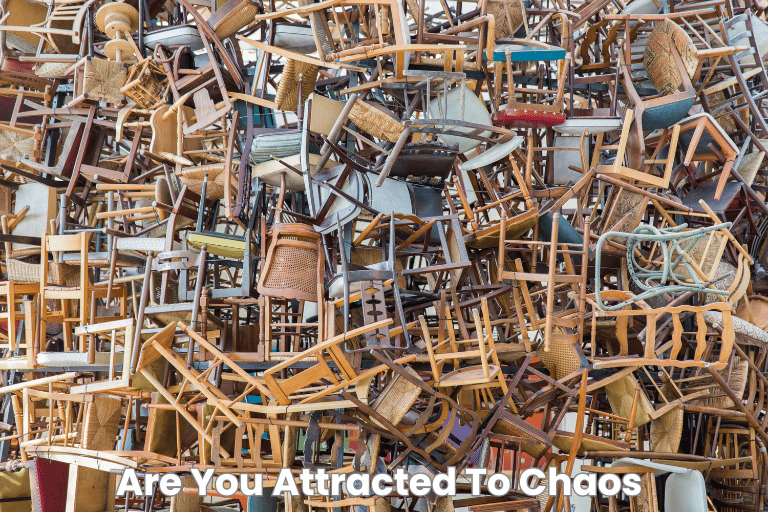Are You Attracted to Chaos and Drama?
Does Intensity Equal Being Alive?
Some people don’t realize they’re drawn to chaos until life becomes quiet.
That’s when it starts creeping in again, through restlessness, conflict, overstimulation, or unnecessary complications.
Not everyone’s chasing drama on purpose.
But for a lot of people, it’s familiar. It’s wired in.
And when things feel calm for too long, that calm doesn’t feel normal.
The Pull Toward Drama Isn’t Always Obvious
You might say you’re tired of the stress. You want things to settle.
But once they do, something doesn’t sit right.
You feel bored. Disconnected. On edge.
And instead of staying in the quiet, you start poking around for something to fix, stir up, or react to.
It might show up like this:
Picking arguments that don’t need to happen
Reaching for stimulation when nothing’s going on
Making impulsive choices just to feel something again
Exaggerating stories for effect, just to bring intensity back into the room
Jumping from routine to routine because stillness feels too still
This doesn’t always mean you love chaos.
But if calm makes you uneasy, there’s a reason.
Internal vs External Chaos
Chaos shows up in two places: inside you and around you.
Both are disruptive. But they work in different ways.
Internal chaos is mental and emotional.
It’s that racing-thought feeling. Constant self-doubt. Mood swings. Fear of the future.
It often shows up as:
Overwhelm without an obvious source
Feeling like everything’s urgent
Inability to focus
Always second-guessing yourself
Feeling unsafe even when nothing is wrong
External chaos lives in your environment and relationships.
It’s the messy apartment, the stacked calendar, the people who always seem to bring drama.
It can look like:
Constant emergencies
Sudden changes that throw everything off
Chaotic social interactions that drain you
Too much information, too fast, all the time
You might live in one. You might live in both. But they feed off each other.
And often, when internal chaos gets quiet, people unconsciously recreate it externally - just to feel “normal” again.
Why It Happens
Nobody wakes up thinking, “I want to create chaos today.”
But certain patterns make it hard to live without it.
If you grew up around chaos, it shaped your baseline.
Your body learned to be on high alert. You expected disruption. You planned for worst-case scenarios.
That early wiring doesn’t just disappear.
As an adult, you might seek out intensity, not because you want it, but because you’re conditioned to expect it.
You might also be addicted to the rush that chaos brings.
That spike of adrenaline when a crisis hits. A burst of clarity when there’s a problem to solve.
It feels like focus. Like purpose. Like something that matters.
But what’s happening is emotional dysregulation - your nervous system never learned how to feel calm without needing an emergency to justify it.
And when calm finally shows up, it feels off.
Not peaceful. Just empty.
Which is why some people stir things up again, just to bring back a feeling they can understand.
Where It Comes From
This isn’t just behavior. There’s always a root cause.
Childhood instability: If calm never existed growing up, it’s not going to feel safe now
Neglect or unpredictability: If your early relationships were inconsistent, your nervous system may link “chaos” with attention, care, or control
Lack of emotional tools: If nobody taught you how to regulate emotions, chaos becomes a coping mechanism—it gives you something to do with all the feeling
Reward loops: If you were praised for “handling the crisis,” you learned that being in chaos made you useful
So you repeat it. Not to hurt yourself, but to find something that feels real.
What It Might Look Like in Real Life
You might already sense the pattern. But here’s how it tends to show up:
You’re always in the middle of the chaos. If there’s a mess, a breakdown, or a crisis, you’re usually the one trying to scoop water out of the sinking ship.
You’re drawn to attention, even when it’s negative. The silence that follows being overlooked feels worse than the noise that comes from being in trouble.
You pick fights. Sometimes to be heard. Sometimes just to feel something. And once it starts, you go all in, yelling, escalating, trying to win something you didn’t really want to start.
You retell stories like they’re events. And you dramatize them without meaning to—because telling it straight doesn’t give the same hit.
You feel oddly calm when everything is falling apart. That’s the part that should make you pause.
If any of that feels familiar, it probably means you’re stuck in a stress-response loop.
You cope with high anxiety, then create more tension to manage the fallout.
And the rush that comes with it - anger, adrenaline, urgency - keeps the whole thing going.
What You Can Do With That Awareness
You do need to notice the pattern.
Next time the urge shows up, to stir, to react, to create intensity, ask yourself something simple:
Is this necessary? Or is it familiar?
That question alone can break the loop.
Not every time. But enough to remind you that calm isn’t the enemy.
It’s just your nervous system learning something new.



Chaos can feel more comfortable than calm when that’s your baseline. I’ve caught myself chasing “busy” just to feel like I’m doing enough, filling up every gap so there’s no space to pause. It’s a pattern I know I’ve carried since childhood, and one I’ve seen modeled around me too. Still learning that stillness doesn’t mean something’s wrong, it just means I’m safe enough to slow down.